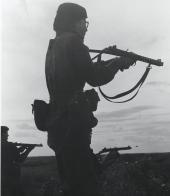
The Canadian Forces training area known as Camp Dundurn is located about 35 km south of Saskatoon in what is primarily a raw prairie region of sand, sprinkled with poplar bluffs. The area was first used as early as 1928 for militia exercises. For the first few summer militia exercises, men slept in tents because there were no permanent structures for habitation or operations. The land began to be cleared for a permanent militia training camp by local labour in 1930. Camp Dundurn was also used as an ammunition storage depot. During the Great Depression, a relief camp was established at Dundurn under the authority of the Department of National Defence; there, men worked for 20¢ a day plus meals, tobacco, lodging and work clothes. The relief camp included barracks-style accommodation for up to 2,000 men, a hospital, a recreation hall, and a fully functional water system. There was unrest at Camp Dundurn when 200 men went to Regina to join the On-to-Ottawa trek, until it was quashed at the Regina Riot of July 1, 1935. Dissatisfaction simmered at Dundurn, and a strike began on December 12, 1935, when two men were evicted. Despite calls from camp and other authorities to apply forceful measures, a peaceful settlement to the strike was negotiated on January 22, 1936. Federal relief camps were phased out in the summer of 1936.
With the outbreak of World War II in 1939, Camp Dundurn was transformed into a bustling military base, the largest in Saskatchewan. Facilities were expanded to accommodate an armoured corps training school, an engineer training unit, a large hospital, a nurses' residence, a Canadian Women's Army Corps barracks, a fire hall, and an extended training area. More than 50,000 soldiers trained at Camp Dundurn before being assigned to duty overseas. Reserve soldiers who were exempt from active service also went through compulsory training there. Since World War II the camp has remained in military hands, and it operates today as Canadian Forces Detachment Dundurn. Permanent personnel have been reduced to less than 200, but the site maintains its role as an ammunition storage and training area. Activity peaks in the summer, when cadet and reserve army units arrive for extended training exercises.
John Chaput